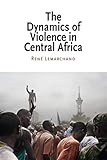The Dynamics of Violence in Central Africa / René Lemarchand, Rene Lemarchand.
Material type: TextSeries: National and Ethnic Conflict in the 21st CenturyPublisher: Philadelphia : University of Pennsylvania Press, [2012]Copyright date: ©2009Description: 1 online resource (344 p.) : 10 illusContent type:
TextSeries: National and Ethnic Conflict in the 21st CenturyPublisher: Philadelphia : University of Pennsylvania Press, [2012]Copyright date: ©2009Description: 1 online resource (344 p.) : 10 illusContent type: - 9780812220902
- 9780812202595
- 967.03
- online - DeGruyter
- Issued also in print.
| Item type | Current library | Call number | URL | Status | Notes | Barcode | |
|---|---|---|---|---|---|---|---|
 eBook
eBook
|
Biblioteca "Angelicum" Pont. Univ. S.Tommaso d'Aquino Nuvola online | online - DeGruyter (Browse shelf(Opens below)) | Online access | Not for loan (Accesso limitato) | Accesso per gli utenti autorizzati / Access for authorized users | (dgr)9780812202595 |
Frontmatter -- Contents -- Preface -- Part I. The Regional Context -- Chapter 1: The Geopolitics of the Great Lakes Region -- Chapter 2: The Road to Hell -- Part II. Rwanda and Burundi: The Genocidal Twins -- Chapter 3: Ethnicity as Myth -- Chapter 4: Genocide in the Great Lakes: Which Genocide? Whose Genocide? -- Chapter 5: The Rationality of Genocide -- Chapter 6: Hate Crimes -- Chapter 7: The Politics of Memory -- Chapter 8: Rwanda and the Holocaust Reconsidered -- Chapter 9: Burundi 1972: A Forgotten Genocide -- Chapter 10: Burundi at the Crossroads -- Chapter 11: Burundi's Endangered Transition -- Part III. The Democratic Republic of the Congo: From Failed State to Fragile Transition -- Map 5 -- Chapter 12: A Blocked Transition: Zaire in 1993 -- Chapter 13: Ethnic Violence, Public Policies, and Social Capital in North Kivu -- Chapter 14: The DRC: From Failure to Potential Reconstruction -- Chapter 15: The Tunnel at the End of the Light -- Chapter 16: From Kabila to Kabila: What Else Is New? -- Notes -- Index -- Acknowledgments
restricted access online access with authorization star
http://purl.org/coar/access_right/c_16ec
Endowed with natural resources, majestic bodies of fresh water, and a relatively mild climate, the Great Lakes region of Central Africa has also been the site of some of the world's bloodiest atrocities. In Rwanda, Burundi, and the Congo-Kinshasa, decades of colonial subjugation-most infamously under Belgium's Leopold II-were followed by decades of civil warfare that spilled into neighboring countries. When these conflicts lead to horrors such as the 1994 Rwandan genocide, ethnic difference and postcolonial legacies are commonly blamed, but, with so much at stake, such simple explanations cannot take the place of detailed, dispassionate analysis.The Dynamics of Violence in Central Africa provides a thorough exploration of the contemporary crises in the region. By focusing on the historical and social forces behind the cycles of bloodshed in Rwanda, Burundi, and the Congo-Kinshasa, René Lemarchand challenges much of the conventional wisdom about the roots of civil strife in former Belgian Africa. He offers telling insights into the appalling cycle of genocidal violence, ethnic strife, and civil war that has made the Great Lakes region of Central Africa the most violent on the continent, and he sheds new light on the dynamics of conflict in the region.Building on a full career of scholarship and fieldwork, Lemarchand's analysis breaks new ground in our understanding of the complex historical forces that continue to shape the destinies of one of Africa's most important regions.
Issued also in print.
Mode of access: Internet via World Wide Web.
In English.
Description based on online resource; title from PDF title page (publisher's Web site, viewed 24. Apr 2022)


